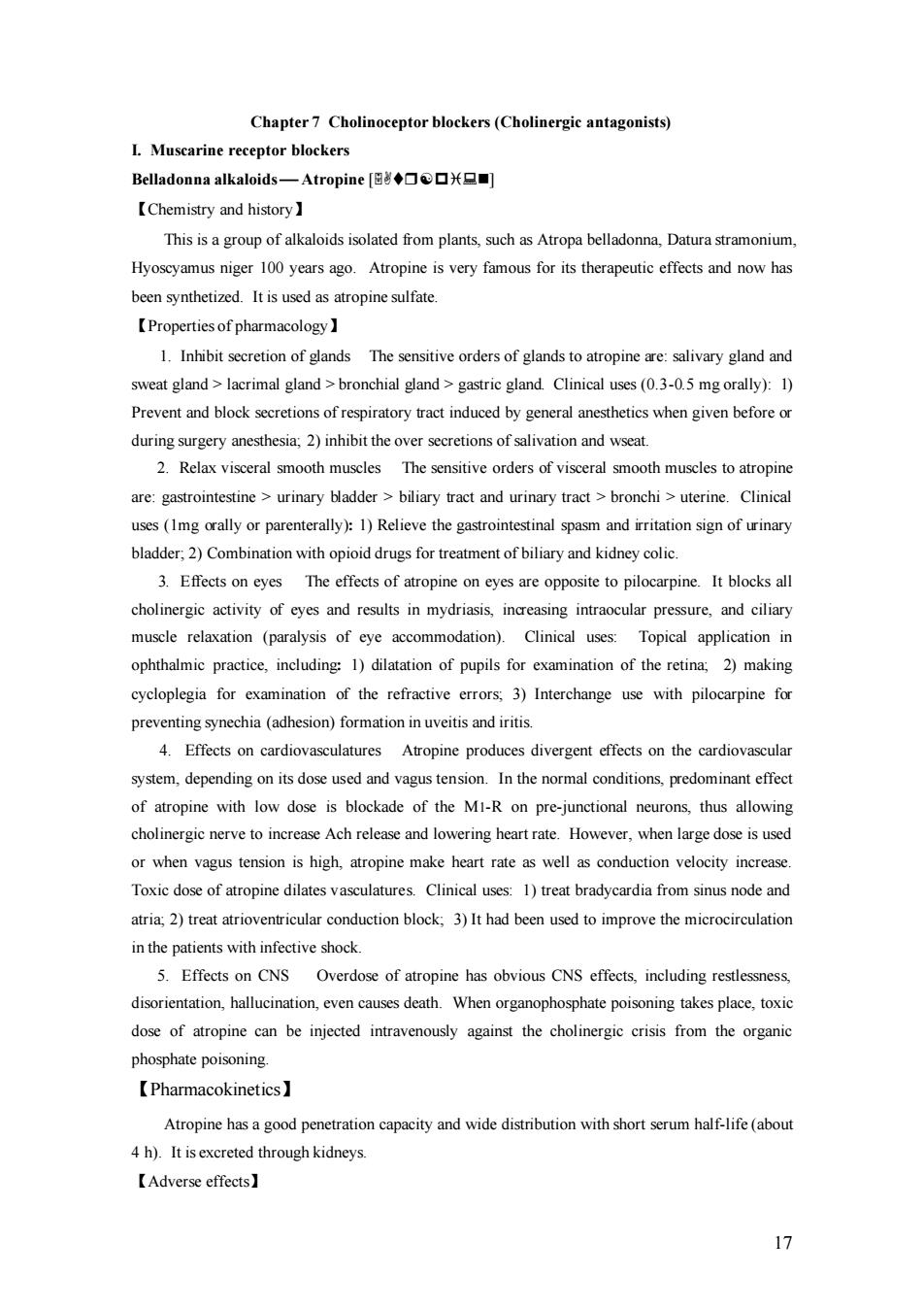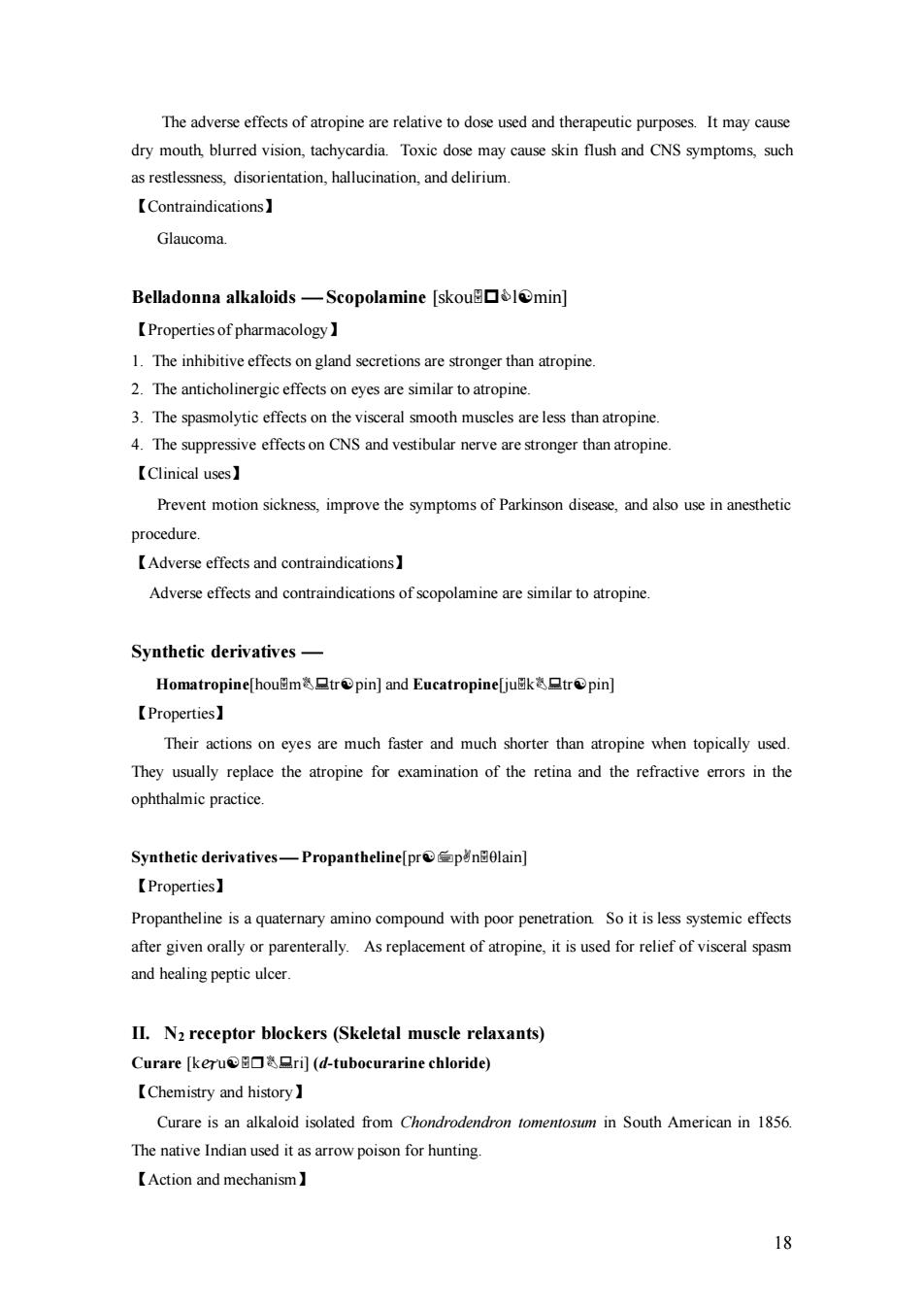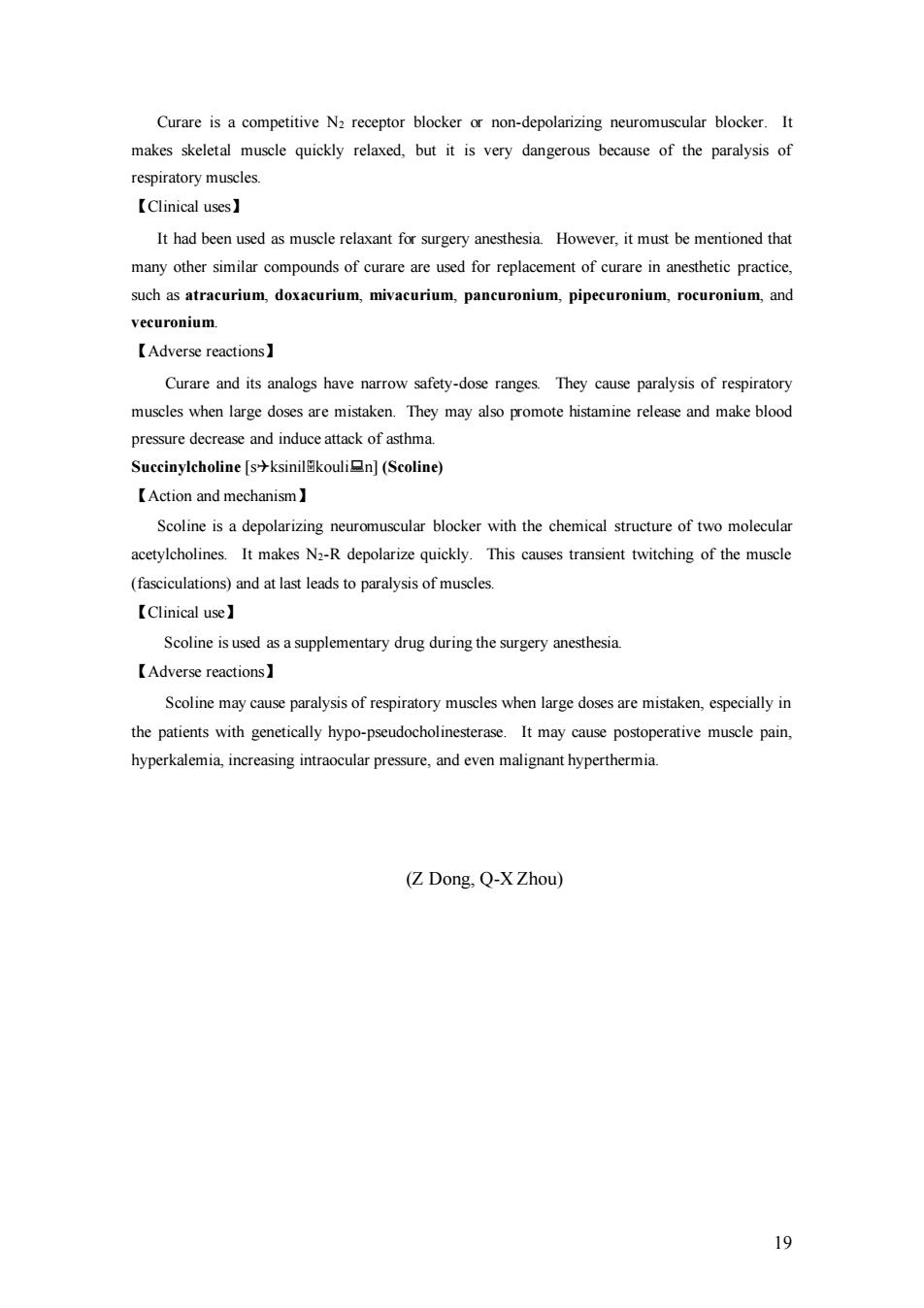
myasthenia gravis.Myasthenia gravis is an autoimmune disease caused by antibodies of N-R. which bind to the recepors and induce the degradation of the receptors 2.Treat bowel paralysis and urinary retention 3.Treat supraventricular tachycardias. 【Adverse reaction】 The adverse reactions of neostigmine are mainly relative to its generating cholinergic effects, including abdominal pain,.bronchospasm. Tacrine [t:Ekrin] 【Chemistry and history】 Tacrine is asynthetic(tetrahydroaminoacridine.THA)compound. 【Properties of pharmacology】 Tacrine hydrochloride is a reversible ChE I and has a highly central selectivity.It is used to improve the symptoms of Alzheimer's disease.but it does not ater the course of the disease.Initial dose:10mg qid x at least 6 weeks:then 20mg qid x6 weeks,then 30mg qid x6 weeks,up to 40mg qid 【Adverse reaction】 17%50%patients must stop treating because of severe side effects,such as confusion,agitation, ataxia,myalgia,anorexia,diarrhea,dyspepsia,nausea,vomiting some patients have increasing serum ALP level. (Z Dong.Q-X Zhou) 16
16 myasthenia gravis. Myasthenia gravis is an autoimmune disease caused by antibodies of N2-R, which bind to the receptors and induce the degradation of the receptors. 2. Treat bowel paralysis and urinary retention 3. Treat supraventricular tachycardias. 【Adverse reaction】 The adverse reactions of neostigmine are mainly relative to its generating cholinergic effects, including abdominal pain, diarrhea, salivation, flushing, nausea, and bronchospasm. Tacrine [t:krin] 【Chemistry and history】 Tacrine is a synthetic aminoacridine (tetrahydroaminoacridine, THA) compound. 【Properties of pharmacology】 Tacrine hydrochloride is a reversible ChE I and has a highly central selectivity. It is used to improve the symptoms of Alzheimer’s disease, but it does not alter the course of the disease. Initial dose: 10mg qid at least 6 weeks; then 20mg qid 6 weeks; then 30mg qid 6 weeks, up to 40mg qid. 【Adverse reaction】 17% - 50% patients must stop treating because of severe side effects, such as confusion, agitation, ataxia, myalgia, anorexia, diarrhea, dyspepsia, nausea, vomiting; some patients have increasing serum ALP level. (Z Dong, Q-X Zhou)

Chapter7 Cholinoceptor blockers(Cholinergic antagonists) 1.Musearine receptor blockers Belladonna alkaloids-一Atropine但影◆ae口t旦J 【Chemistry and history】 This is a group of alkaloids isolated from plants,such as Atropa belladonna,Datura stramonium Hyoscyamus niger 100 years ago.Atropine is very famous for its therapeutic effects and now has been synthetized.It is used as atropine sulfate 【Properties of pharmacology】 1.Inhibit secretion of glands The sensitive orders of glands to atropine are:salivary gland and sweat glandlacrimal gland>bronchial glandgastric gland Clinical uses(3-05mgorally):1) Prevent and block secretions of respiratory tract induced by general anesthetics when given before or during surgery anesthesia.)inhibit the over secretions of and wseat 2.Relax visceral smooth muscles The sensitive orders of visceral smooth muscles to atropine are:gastrointestine>urinary bladder>biliary tract and urinary tract>bronchi>uterine.Clinical uses(1mg rally or parenterally):1)Relieve the gastrointestinal spasm and rritation sign of inary bladder,2)Combination with opioid drugs for treatment of biliary and kidney colic. 3.Efectson eyes The effects of atropine on eyes are opposite to pilocarpine.It blocks all cholinergic activity of eyes and results in mydriasis,increasing intraocular pressure.and ciliary muscle relaxation (paralysis of eye accommodation).Clinical uses Topical application in ophthalmic practice,including:1)dilatation of pupils for examination of the retina:2)making cycloplegia for examination of the refractive errors 3)Interchange use with pilocarpine fo preventing synechia (adhesion)formation in uveitis and iritis. 4.Effects on cardiovasculatures Atropine produces divergent effectson the cardiovascular system.depending on its dose used and vagus tension.In the normal conditions.predominant effect of atropine with low dose is blockade of the MI-R on pre-junctional neurons,thus allowing cholinergic nerve to increase Ach release and lowering heart rate.However,when large dose is used or when vagus tension is high,atropine make heart rate as well as conduction velocity increase Toxic dose of atropine dilates vasculatures.Clinical uses:1)treat bradycardia from sinus node and atria,2)treat atrioventricular conduction block;3)It had been used to improve the microcirculation in the patients with infective shock. 5.Effects on CNS Overdose of atropine has obvious CNS effects,including restlessness. ,hallucination,even causes death.When organophosphate poisoning takes pace,toxic dose of atropine can be injected intravenously against the cholinergic crisis from the organic 【Pharmacokinetics】 Atropine has a good penetration capacity and wide distrbution half-life(about 4h).It isexcreted through kidneys 【Adverse effects】 17
17 Chapter 7 Cholinoceptor blockers (Cholinergic antagonists) I. Muscarine receptor blockers Belladonna alkaloids ⎯ Atropine [⧫◼] 【Chemistry and history】 This is a group of alkaloids isolated from plants, such as Atropa belladonna, Datura stramonium, Hyoscyamus niger 100 years ago. Atropine is very famous for its therapeutic effects and now has been synthetized. It is used as atropine sulfate. 【Properties of pharmacology】 1. Inhibit secretion of glands The sensitive orders of glands to atropine are: salivary gland and sweat gland > lacrimal gland > bronchial gland > gastric gland. Clinical uses (0.3-0.5 mg orally): 1) Prevent and block secretions of respiratory tract induced by general anesthetics when given before or during surgery anesthesia; 2) inhibit the over secretions of salivation and wseat. 2. Relax visceral smooth muscles The sensitive orders of visceral smooth muscles to atropine are: gastrointestine > urinary bladder > biliary tract and urinary tract > bronchi > uterine. Clinical uses (1mg orally or parenterally): 1) Relieve the gastrointestinal spasm and irritation sign of urinary bladder; 2) Combination with opioid drugs for treatment of biliary and kidney colic. 3. Effects on eyes The effects of atropine on eyes are opposite to pilocarpine. It blocks all cholinergic activity of eyes and results in mydriasis, increasing intraocular pressure, and ciliary muscle relaxation (paralysis of eye accommodation). Clinical uses: Topical application in ophthalmic practice, including: 1) dilatation of pupils for examination of the retina; 2) making cycloplegia for examination of the refractive errors; 3) Interchange use with pilocarpine for preventing synechia (adhesion) formation in uveitis and iritis. 4. Effects on cardiovasculatures Atropine produces divergent effects on the cardiovascular system, depending on its dose used and vagus tension. In the normal conditions, predominant effect of atropine with low dose is blockade of the M1-R on pre-junctional neurons, thus allowing cholinergic nerve to increase Ach release and lowering heart rate. However, when large dose is used or when vagus tension is high, atropine make heart rate as well as conduction velocity increase. Toxic dose of atropine dilates vasculatures. Clinical uses: 1) treat bradycardia from sinus node and atria; 2) treat atrioventricular conduction block; 3) It had been used to improve the microcirculation in the patients with infective shock. 5. Effects on CNS Overdose of atropine has obvious CNS effects, including restlessness, disorientation, hallucination, even causes death. When organophosphate poisoning takes place, toxic dose of atropine can be injected intravenously against the cholinergic crisis from the organic phosphate poisoning. 【Pharmacokinetics】 Atropine has a good penetration capacity and wide distribution with short serum half-life (about 4 h). It is excreted through kidneys. 【Adverse effects】

The adverse effects of atropine are relative to dose used and therapeutic purposes.It may cause dry mouth blurred vision,tachycardia.Toxic dose may flush and CNS ymptoms such as restlessness,disorientation,hallucination,and delirium. 【Contraindications】 Glaucoma Belladonna alkaloids-Scopolamine [skoumin] 【Properties of pharmacology】 1.The inhibitive effectsongland secretionsare stronger than atropine 2.The anticholinergic effects on eyes are similar to atropine. 3.The spasmolytic effects on the visceral smooth muscles are less than atropine. 4.The suppressive effectson CNS and vestibular nerve are stronger than atropine. 【Clinical uses】 Prevent motion sickness,improve the symptoms of Parkinson disease,and also use in anestheti procedure. 【Adverse effects and contraindications】. Adverse effects and contraindications of scopolamine are similar to atropine Synthetic derivatives- Homatropine[houmtrpin]and Eucatropine[juktrpin 【Properties】 Their actions on eyes are much faster and much shorter than atropine when topically used. They usually replace the atropine for examination of the retina and the refractive errors in the ophthalmic practice Synthetic derivatives-Propantheline[prpn0lain] 【Properties】 Propantheline is a quaternary amino compound with poor penetration So it is less systemic effects after given orally or parenterally.As replacement of atropine.it is used for relief of visceral spasm and healing peptic ulcer II.N2 receptor blockers (Skeletal muscle relaxants) Curare [keruri](d-tubocurarine chloride) 【Chemistry and history】 Curare is an alkaloid isolated from Chondrodendron tomentosum in South American in 1856. The native Indian used it as arrow poison for hunting. 【Action and mechanism】
18 The adverse effects of atropine are relative to dose used and therapeutic purposes. It may cause dry mouth, blurred vision, tachycardia. Toxic dose may cause skin flush and CNS symptoms, such as restlessness, disorientation, hallucination, and delirium. 【Contraindications】 Glaucoma. Belladonna alkaloids ⎯ Scopolamine [skoulmin] 【Properties of pharmacology】 1. The inhibitive effects on gland secretions are stronger than atropine. 2. The anticholinergic effects on eyes are similar to atropine. 3. The spasmolytic effects on the visceral smooth muscles are less than atropine. 4. The suppressive effects on CNS and vestibular nerve are stronger than atropine. 【Clinical uses】 Prevent motion sickness, improve the symptoms of Parkinson disease, and also use in anesthetic procedure. 【Adverse effects and contraindications】 Adverse effects and contraindications of scopolamine are similar to atropine. Synthetic derivatives ⎯ Homatropine[houmtrpin] and Eucatropine[juktrpin] 【Properties】 Their actions on eyes are much faster and much shorter than atropine when topically used. They usually replace the atropine for examination of the retina and the refractive errors in the ophthalmic practice. Synthetic derivatives ⎯ Propantheline[prpnθlain] 【Properties】 Propantheline is a quaternary amino compound with poor penetration. So it is less systemic effects after given orally or parenterally. As replacement of atropine, it is used for relief of visceral spasm and healing peptic ulcer. II. N2 receptor blockers (Skeletal muscle relaxants) Curare [kuri] (d-tubocurarine chloride) 【Chemistry and history】 Curare is an alkaloid isolated from Chondrodendron tomentosum in South American in 1856. The native Indian used it as arrow poison for hunting. 【Action and mechanism】

Curare is a competitive N2 receptor blocker or non-depolarizing neuromuscular blocker.It makes skeletal muscle quickly relaxed.but it is very dangerous because of the paralysis of respiratory muscles. 【Clinical uses】 It had been used as muscle relaxant for surgery anesthesia However,it must be mentioned tha many other similar compounds of curare are used for replacement of curare in anesthetic practice, such as atracurium,doxacurium,mivacurium pancuronium,pipecuronium,rocuronium,and vecuronium. 【Adverse reactions】 Curare and its analogs have narrow safety-dose ranges.They cause paralysis of respiratory muscles when large doses are mistaken.They may also promote histamine release and make blood pressure decrease and induce attack of asthma Succinylcholine [s+ksinilkoulin](Scoline) 【Action and mechanism】 Scoline is a depolarizing neuromuscular blocker with the chemical structure of two molecular acetylcholines.It makes N2-R depolarize quickly.This causes transient twitching of the muscle (fasciculations)and at last leads to paralysis of 【Clinical use】 Scoline isused as a supplementary drug during the surgery anesthesia 【Adverse reactions】 Scoline may cause paralysis of respiratory muscles when large doses are mistaken,especially in the patients with genetically hypo-pseudocholinesterase.It may cause postoperative muscle pain, hyperkalemia increasing intraocular pressure and even malignant hyperthermia (Z Dong.Q-X Zhou)
19 Curare is a competitive N2 receptor blocker or non-depolarizing neuromuscular blocker. It makes skeletal muscle quickly relaxed, but it is very dangerous because of the paralysis of respiratory muscles. 【Clinical uses】 It had been used as muscle relaxant for surgery anesthesia. However, it must be mentioned that many other similar compounds of curare are used for replacement of curare in anesthetic practice, such as atracurium, doxacurium, mivacurium, pancuronium, pipecuronium, rocuronium, and vecuronium. 【Adverse reactions】 Curare and its analogs have narrow safety-dose ranges. They cause paralysis of respiratory muscles when large doses are mistaken. They may also promote histamine release and make blood pressure decrease and induce attack of asthma. Succinylcholine [sksinilkoulin] (Scoline) 【Action and mechanism】 Scoline is a depolarizing neuromuscular blocker with the chemical structure of two molecular acetylcholines. It makes N2-R depolarize quickly. This causes transient twitching of the muscle (fasciculations) and at last leads to paralysis of muscles. 【Clinical use】 Scoline is used as a supplementary drug during the surgery anesthesia. 【Adverse reactions】 Scoline may cause paralysis of respiratory muscles when large doses are mistaken, especially in the patients with genetically hypo-pseudocholinesterase. It may cause postoperative muscle pain, hyperkalemia, increasing intraocular pressure, and even malignant hyperthermia. (Z Dong, Q-X Zhou)

Chapter 8 Adrenergic agonists(Adrenoceptor agonists, Sympatheticomimetic drugs) Classifications 1.a-receptor agonist,B-receptor agonist,a-B-receptor agonist. 2.Central sympatheticomimetic drugs and peripheral sympatheticomimetic drugs. 3.Catecholamines(CA),Non-catecholamines. ○4pK B-phenylethylamine catechol Relationships among structure,pharmacodynamics and pharmacokinetics 1.Catecholamine Bioavailability is very low after given orally;hardly penetrate blood-brain barrier,easily destroyed by COMT and MAO:the effects start quickly and are strong but last very short time. 2.Non-catecholamine Almost opposite to catecholamine. 3.No-OH on phenyl ring High bioavailability after given orally:strong stimulation of CNS and weak peripheral actions:the effects last much longer. 4.Substitutionon the amin group -receptoranist-ikectio 5.Substitution on the a-carbon Not easily destroyed by MAO and displacing CA from the storage sites of terminals. 6.Substitution on the B-carbon May be important to keep peripheral actions of drugs Important adrenoceptor agonists Noradrenaline[n:rdrenli:n](NA),Norepinephrine[n:repinefrin](NE) It is a natural catecholamine,with strong R and Ractivity,medial -Ractivity,and without B:-Raction 【Actions of pharmacology】 1.Heart B-R+HRT,contractility,conductionT,cardiac output (CO),systolic pressure Oz consumption 2.Vessels Skin mucosa,and visceral vessels:Rcontraction,peripheral resistance (R)diastolic pressure. Thus,the mean blood pressure (BP).Because of BP the compensatory vagus nerve excitation increases,HR may 【Clinical uses】 1.Treat low BP symptoms caused by some drugs or the disorders of autonomic nervous system. 汤
20 Chapter 8 Adrenergic agonists (Adrenoceptor agonists, Sympatheticomimetic drugs) Classifications 1、-receptor agonist, -receptor agonist, -, -receptor agonist. 2、Central sympatheticomimetic drugs and peripheral sympatheticomimetic drugs. 3、Catecholamines (CA), Non-catecholamines. CH-CH-N HO HO -phenylethylamine catechol Relationships among structure, pharmacodynamics and pharmacokinetics 1. Catecholamine Bioavailability is very low after given orally; hardly penetrate blood-brain barrier; easily destroyed by COMT and MAO; the effects start quickly and are strong, but last very short time. 2. Non-catecholamine Almost opposite to catecholamine. 3. No –OH on phenyl ring High bioavailability after given orally; strong stimulation of CNS and weak peripheral actions; the effects last much longer. 4. Substitution on the amino group -receptor agonist-like action . 5. Substitution on the - carbon Not easily destroyed by MAO and displacing CA from the storage sites of terminals. 6. Substitution on the - carbon May be important to keep peripheral actions of drugs. Important adrenoceptor agonists Noradrenaline[n:rdrenli:n] (NA), Norepinephrine[n:repinefrin] (NE) It is a natural catecholamine, with strong 1-R and 2- R activity, medial 1-R activity, and without 2-R action. 【Actions of pharmacology】 1. Heart 1-R ++, HR, contractility,conduction, cardiac output (CO), systolic pressure, O2 consumption. 2. Vessels Skin, mucosa, and visceral vessels: 1-R +++, contraction, peripheral resistance (R), diastolic pressure. Thus, the mean blood pressure (BP). Because of BP, the compensatory vagus nerve excitation increases, HR may . 【Clinical uses】 1. Treat low BP symptoms caused by some drugs or the disorders of autonomic nervous system